
Charles Hilgenhurst Medallion
How the recent renovation at the Government Center MBTA station killed a view of a Boston landmark.
Between King Burial Grounds and Granary Burying Ground is a small medallion on the sidewalk pavement. The medallion is a bit hidden and is probably missed by many tourists walking between King Burial Grounds and Boston Commons.
Here is a picture of the medallion that is in front of the Omni Parker House:
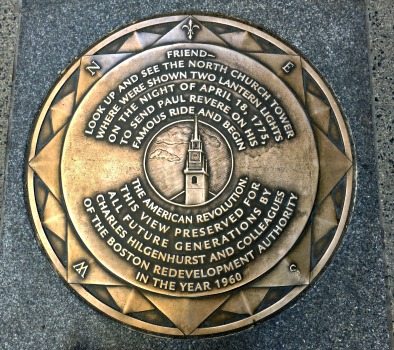
The inscription reads:
March 21, 2016
Today when you look up towards the King Burial Grounds, to see The North Church Tower, this is what you see:
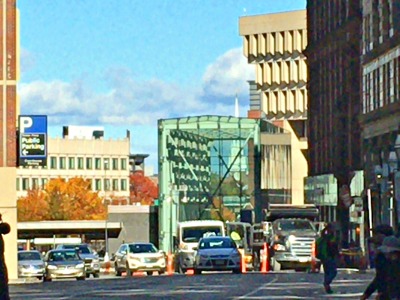
When the MBTA redesigned the Government Center back in 2014, they added a 40-foot glass structure. However, didn't take into account blocking the North Church Tower. You can still see part of the church through the glass structure, but the view is definitely blocked. At night, the glass structure is blue, which would completely prevent you from seeing the Church tower.
I wasn't able to find any information on why Charles Hilgenhurst wanted the view to be visible from the Omni Parker House. There isn't any document online or at the Boston Public Library about installing the medallion.
Locating the Marker
The medallion is located 3,580.80 feet (1091.43 meters) from the The North Church.
The medallion is located on Boylston Street, near the intersection of School Street. The GPS coordinates is: 42.357675, -71.060633
PermalinkBoston Radio Graphic
This week's post highlights some of Boston most popular radio stations. I created a reference chart to where you can find those stations on the dial.
Top Three Stations
WROR, Boston's Greatest Hits Station, continues to dominate the Boston radio market. Month after Month they are what Bostonians are listing to all day.
WMJX, Magic 106.7, is a mass appeal radio station that plays songs that have stood the test of time, along with the best new music in the contemporary arena today. You’ll hear Maroon 5, Bruno Mars, Bon Jovi, Katy Perry, Kelly Clarkson, Michael Jackson, Taylor Swift, Pink and Elton John…it’s the best variety anytime!
Boston is a huge sports town and people like to talk sports over local politics. WBZ, the Sports Hub, and WEEI are neck and neck fighting to entertain their listeners.
General Talk Radio is very limited in the Boston Market. It seems that WRKO is that last of the major stations to survive.
Radio Dial Graphic
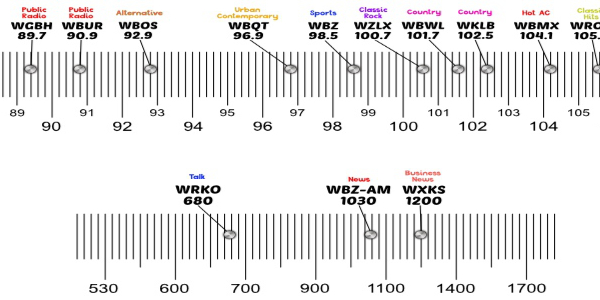
Click on image for a larger version.
Download Boston's Radio Graphic to discover where the top 13 stations are on the radio dial. This is useful if you're setting up the station memory slots on your car radio.
If you want a higher resolution copy for print, let me know and I'll send you a high-quality PDF version.
I'll update the graphic anytime there are major changes to any of the stations.
Blogging Notes
For those that were disappointed about not learning anything about Boston's history. We'll go back to exploring various sites around Boston - next week.
If you have any site that you want featured, let me know!
PermalinkCentral Burial Grounds
In Boston, there are four major cemeteries that opened during the Colonial period.
| Place | Years in Operation | Number of Interments |
|---|---|---|
| King Chapel | 1630 - 1660 | 1,500 people |
| Old Granary Burial Ground | 1660 - 1856 | 5,000 people |
| Copp's Hill Burying Ground | 1659 - 1968 | 10,000 people |
| Central Burial Grounds | 1756 - 1836 | 5,000 people |
The one that is most likely to be haunted is the Central Burial Grounds. That is because of a couple of major events that have happened at the cemetery.
Brief History of the Grounds
The need for a third burial grounds came about because of the continued growth of the city of Boston. It was established on the Boston Common in 1756. It is located on Boylston Street between Tremont Street and Charles Street.
The grounds were actually not all that desire of a place because it was further away from the main part of the city. Many of the city poor were buried here. Many children were buried here.
British Soldiers
During the occupation of Boston, the British buried their dead in the Central Burial Grounds. They either died in combat or as a result of disease during the occupation of Boston, and the various battles around the city.
First Disturbance - Boylston Street Expansion
In 1836, Boston Mayor Samuel Armstrong requested extending Boylston Street to connect with Tremont Street. As a result, a considerable part of the cemetery had to be eliminated and a row of tombs had to be moved to make room for the street.
The tombs were relocated in a long barrow, which is called the "The Dell."
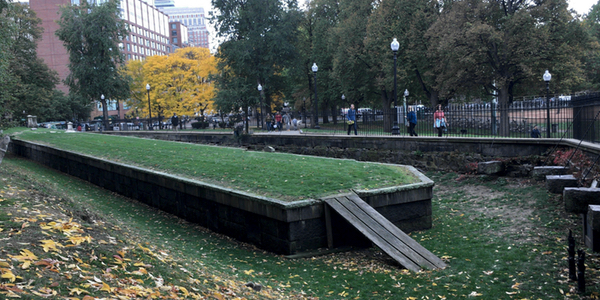
The Dell at the Central Burial Grounds.
Second Disturbance - The Subway Construction
In 1894, when the Tremont Street Subway was under construction, burials were discovered in the area near the cemetery. These were reinterred in a mass grave within the bounds of the burying ground.
Many of the 900 bodies that were found were the British soldiers who died during the Boston occupation 100 years earlier.
The mass grave has a slate table and three boundary stones to mark the spot of those that were relocated.
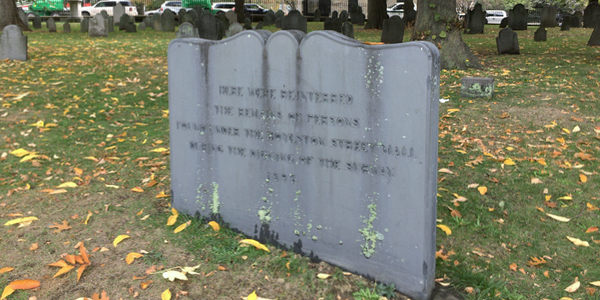
There were a couple of strange events that happened near the cemetery after the two disturbances.
Tremont Street Gas Explosion
On March 4, 1897, a gas explosion took place just a few feet from the Central Burial Grounds. In all six people were killed and at least sixty were injured. All the buildings in the area were shaken and windows in the area were broken.
The total damage cost, other than the loss of six people, was $10,000. (Equivalent to $287,196.15 in 2015) Most of that was for all the broken windows in the buildings.
At the time there was a well-known issue with a gas leak at the Boylston as many people reported the strong gas smell to the gas company. The gas company was negligent for not responding in time.
However, since it happened near the cemetery and shortly after the move of many graves, some think that a paranormal event occurred.
Emerson College Construction Collapse
In 2006, a horrific accident occurred during construction at the Emerson Dormitory building on Boylston Street. This was the first building being constructed opposite the cemetery in roughly 80 years.
On April 6, 2006, a large scaffold collapsed, and three people tragically lost their lives. An investigation went into the accident and discovered that it was a worker procedure error that caused the crane to collapse.
Girl Without a face
There is a ghost story around the Central Burying Ground where a "Girl Without a face" has been spotted wandering around the graveyard. I heard about this story from various sources, and will need to research more for a future blog post.
PermalinkParkman Bandstand
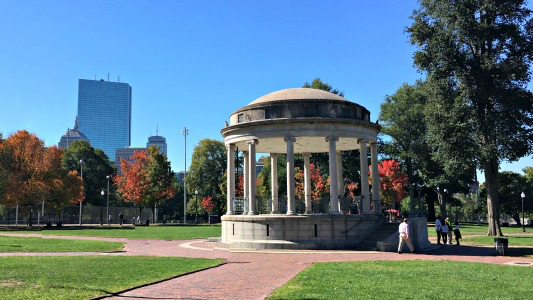
On the eastern side of the Boston Commons is a landmark bandstand. The bandstand is named after George F. Parkman and is officially called the "Parkman Bandstand."
George F. Parkman was the last family member of the Parkman family, a wealthy Bostonian Family. The were consider one of the Boston Brahmin - a class of wealthy, educated, elite members of Boston society in the nineteenth century.
When George Parkman died on September 16, 1908, he gave the city of Boston $5 million for the purpose of taking care of the park. That would be equivalent to $133,064,476.27 in today's value.
This is the second monument that is named after George F. Parkman in the Boston Commons. In front of the visitor center is Parkman Plaza, a circular paved area with three bronze statues representing Industry, Religion, and Learning. The Parkman Plaza was dedicated in 1960.
Interesting Facts
- Parkman Bandstand was open in 1912
- It cost $20,000 to build. ($532,257.91 in today's value)
- Designed by Derby, Robinson and Shepard.
- The Bandstand is modeled after Versailles' Temple d'Amour
- Cow Pond once occupied the site.
- The pond was filled in 1838 when the city of Boston pass an ordinance to ban cattle-grazing on the Commons.
- The Bandstand and pavement around it is about 300 square feet.
- The City of Boston welcome "first night" 1930 with a concert at the Parkman Bandstand
- Charles Lindberg delivered his message from the Parkman Bandstand on July 23, 1927
- Parkman House, 33 Beacon St, Boston, MA, is the Boston's Mayor Official Reception Hall
- The bandstand also gives the Boston Common its most useful platform for public speaking
- It was last restored in 1996 by McKinley Kalsow & Associates
- Handicap ramp was added during the 1996 restoration.
- George F. Parkman is the only person to have 2 monuments named after him in the Boston Commons.
Sign on the Floor
When you walk up the stairs of the Bandstand there is a plaque on the floor that was placed during the 1912 dedication ceremony. The text is all uppercase using an old style too look "clean and classy." This is the old-world style text:
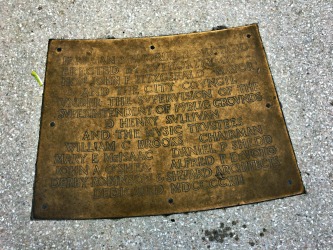 PARKMAN MEMORIAL BANDSTAND
PARKMAN MEMORIAL BANDSTANDERECTED BY AVTHORITY OF
HON JOHN F FITZGERALD MAYOR
AND THE CITY COVNCIL
VNDER THE SVPERVISION OF THE
SVPERINTENDENT OF PVBLIC GROVNDS
D HENRY SVLLIVAN
AND THE MVSIC TRVSTEES
WILLIAM C BROOKS CHAIRMAN
MARY E MCISAAC DANIEL P SHEDD
JOHN A O'SHEA ALFRED P DEVOTO
BERBY ROBINSON & SHEPARD ARCHITECTS
DEVICATED MDCCCCXII
Notable Yearly Events
- On October 23, 2007 it was the location of the Barack Obama and Deval Patrick Rally on Tuesday.
- Johnson and Weld held a rally on August 22, 2016.
- Shakespeare in the Park happens in the Summer
- The yearly "Castle Hill Concours d'Elegance" car show is held every September around Bandstand
Family Story
There is an interesting side story about George Parkman family.
In 1849, George Parkman father, Dr. George Parkman, was murdered at Harvard Medical School in one of the most famous murder cases in Harvard history.
On November 23, 1849, Dr. George Parkman, a successful surgeon, stopped by Harvard Medical School to collect some money from John White Webster, a Harvard professor. Mr. Webster had some problems with paying off the debt and ended up murdering Mr. Parkman. Mr. Webster placed his parts inside a brick wall. A week later the body was discovered by Ephrain Littlefield, a janitor at Harvard Medical School.
The crime and trial of Mr. Webster was an international sensation. Tickets were sold to those that wanted to sit in the courtroom, and six thousand tickets were sold. The trial lasted for 12-days and John White Webster was convicted of Parkman's murder on March 30, 1850 (127 days after the murder).
He was executed on August 30, 1850. That's 280 days after the murder, and 153 days after being convicted.
There are some historians that believe that John White Webster may not have been guilty of murder and that the murder might have been accomplished by Webster's accuser.
Fall Foliage
The Parkman Bandstand is a great place to take pictures of the Boston Foliage:
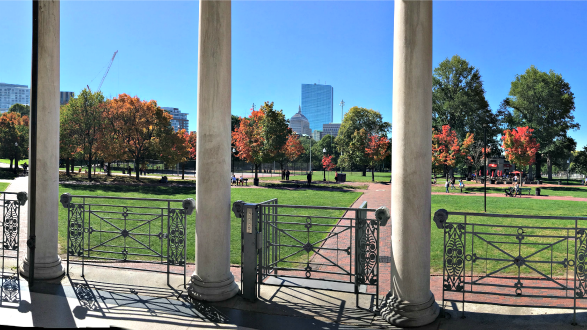
Quack is Back!
The Missing Duck is found and placed in the Boston Public Library
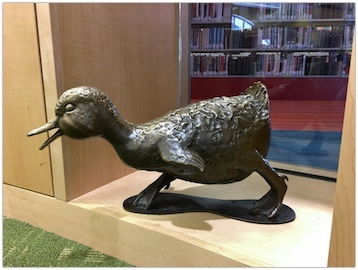
A few months ago I wrote about some information about the "Make Way for Ducklings" statue in the Boston Public Gardens. One of the facts I mentioned was that 2 of the ducklings that were stolen were never returned. I learned this week that one of them did get returned.
In the Children's section of the Boston Public Library Central Branch is "Quack", one of the missing ducks.
Finding Quack
Quack might be hard to find when you bring a child to the Children's section you can play a game to find Quack. You can find Quack in a small window on the front right side as you walk in the Children's section. There might be couches or blocks that could make it hard to see when you walk in. (Simply walk along the right wall.)
After finding Quack, sit down and read the "Make Way for Ducklings" story. It's a lot easier to do it at the library than in the Public Gardens.
There is a little wall sign near the duck statue about the lone duck:
Quack was among eight ducklings and a mother mallard sculpted and cast for the Boston Public Garden by artist Nancy Schon in 1987. The bronze feathered family, one of Boston's most famous public art installations, pay homage to Robert McCloskey's famous children's book Make Way for Ducklings (1941). In the much-loved story, the ducks find their way to a new home on an island in the Public Garden's Lagoon. McCloskey (1914-2003) brought six ducklings to live with him in his New York studio while he was illustrating the tale; he webbed roommates modeled for a series of preparatory sketches that now reside in the Boston Public Library print collection.
Not long after the Public Garden statues were installed, young Quack (the last in the line of ducklings) went missing. Schon cast a duplicate sculpture to replace the figure. In 1988, Quack came back and soon make its way to the Boston Public Library's Children's Library, where it has become a beloved resident.
Gift of Nancy Schon, 1989.
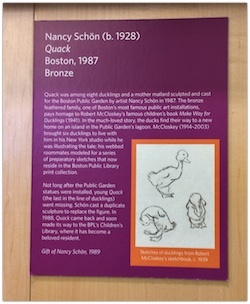
Maybe someday Quack will get united with the rest of the family. Here's a link to the original "Make Way for Ducklings" blog post.
The original Mack statue is still missing! Bring Mack Back!
PermalinkBoston Gaol

The first correctional facility in Boston was called the Boston Gaol and it was located between Court Street and School Street. The jail was in use between 1635-1822. The jail was created less than five years after the city of Boston was founded.
Some people called the Boston Gaol the Boston Stone Jail because of the thick stone walls.
Terminology
The word "Boston Gaol" means a correction facility. the term gaol is used in Australia, New Zealand, Ireland and the United Kingdom. Since the facility was under the British rule, the name Gaol was used instead of jail.
Gaol Inmates
Some notable people that spent time in the prison include:
Captain Kidd - Spent a year in the jail before heading to England to be executed.
Mary Dyer - Visited the jail many times to comfort fellow Quakers. She also sent to jail for refusing an order to leave town. She spent the last night at the Boston Gaol before being executed in the Boston Commons.
Religious Leaders - Quaker's such as Anne Hutchinson were held in jail for being outspoken about their religion.
Salem Witches - Accused Witches were held anyplace that jail space was available.
Solders involved with the Boston Massacre - Were held in the jail in hopes to calm people down.
James Lovell - He was a delegate for Massachusetts to the Continental Congress from 1777 to 1782. He was a signatory to the Articles of Confederation. He was held in the jail as a likely dissident after the Battle of Bunker Hill.
John Leach - kept a journal of his confinement by the British Troops. He was in jail from July 2nd to 17th 1775.
Downfall of the old Boston Gaol
The Boston Goal went through many revisions and relocations over the nearly 200 years of its existence. By the 1820s it was too small to handle the increased jail population.
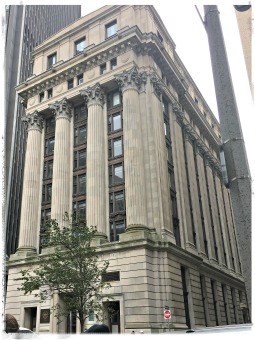
The Leverett Street jail was the success to the Boston Gaol.
Present Day Location of the Boston Gaol
The Boston Gaol has been long gone and the former site is the Boston Public School administration building. Directions to the site of the Boston Goal:
- Take the 'T' to Government Center
- Walk up the stairs and walk over to the Starbuck
- Continue walking past Starbuck and down Court Street.
- Just before you get to Franklin Ave, look across the street. You'll see a building will four tall pillars. This is the site of the Old Boston Gaol.
There is a small sign on the front left of the building to indicate the past history of the location:
Old Prison
The first prison in Boston stood on this site, close to the center of government and trade in the early settlement. In The Scarlet Letter, Nathaniel Hawthorne describes its appearance: "The rust on the ponderous iron-work of its oaken door looked more antique than anything else in the New World...But on one side of the portal, was a wild rose-bush."
Did you know? Captain Kidd was brought here in 1689 after he was captured, and before he was shipped to England to be executed.

Quincy Market
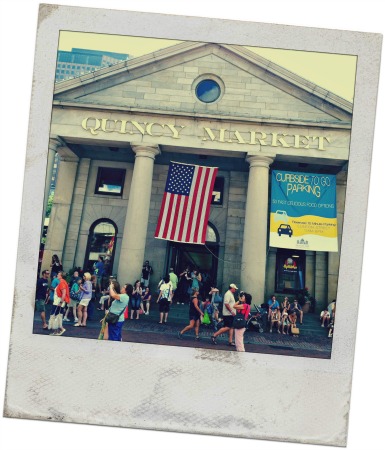
Faneuil Hall is a huge tourist attraction in Boston. Here are five key things that you shouldn't miss on your next visit:
Golden Grasshopper Weathervane
Sitting on top of Quincy Market is the historic Golden Grasshopper. In 1761, a fire at Faneuil Hall damaged the grasshopper weathervane. Thomas Drowne, a blacksmith and the son of the original grasshopper's creator, repaired the weathervane and inserted a "time capsule" in its stomach. The capsule, which is engraved "Food for the Grasshopper," includes historical newspapers, coins, and messages. Whenever the grasshopper gets a major refurbishment the time capsule gets a small update from the sitting mayor.
In 1974, some people thought the Golden Grasshopper was stolen as it went missing for several days. It turns out that some construction workers took down the grasshopper under some flags.
The "Golden Grasshopper" is the last remaining artifact from the 1742 structure.
Kilvert & Forbes Bakeshop
Secretary of state John Kerry got his start in the business world by baking delicious cookies.
If you like large premium cookies, in all sorts of flavors, check out Kilvert & Forbes near the East Market entrance. Get some for now and some for later.
When your placing your order, asked the server when they last saw the current Secretary of State, he usually drops by every once in a while.
Durgan Park
The oldest continuing running restaurant is Durgan Park. They have two big signs outside; "Established Before you were born" and "our Grandfather and perhaps Your Great Grandfather dined with us, too!"
The restaurant opened in 1827 about a year after Quincy Market opened. There was a restaurant at that location since 1742, but it wasn't called Durgan-Park.
There's nothing like trying some classic New England recipes. Not all that hungry? Try some New England chowder with a beer from their large selection. Make sure to stop by the store and take home a souvenir bean pot.
There is a beer garden in the basement floor of the Durgan-Park building. On Wednesday nights there is a comedy show called "Woodstock Wednesdays" starring the local Boston comedy troupe "Just Suspects". Great place to go if you're looking for something to do on a Wednesday evening.
Durgan Park is located in the North Market building. They are open every day for Lunch and dinner.
Quincy Market Dome
On the walls underneath the Quincy Market dome are signs of some of the businesses that once call Quincy Market their home. Some of the business are still going strong today.
Some of the company names that are on the wall:
- Bolton & Hicks
- Julius Lansky & Sons
- Colley-Woods Co.
- H,A, Hovey Co.
- Holland
- Curly Bros. Inc.
- Bartlett. Barney & Co.
- Carroll & Liley
- G. Spinale Co
- 37 Adams Chapman 37 - Still going strong!
When you're standing on the first floor and looking up at the central rotunda, you can see a message in gold lettering. It reads, "This building has served the people of Boston as the central market of the city since its dedication in August 1826."
Other Notable Landmarks
- Samuel Adams Sculpture in front of Faneuil Hall. Not only is he looking away from Faneuil Hall, but the statue is looking directly towards where the real Sam Adam is buried- Granary Burying Grounds.
- Search for the original Boston Harbor Shoreline of 1630. There is a marker on the ground, engraved in granite. Walk past the Samuel Adams statue behind Faneuil Hall towards Congress Street. Hint: You'll see fish skeleton on the cobblestones.
- Stone inscription on the ground between Quincy Market and Faneuil Hall: "Faneuil Hall 1742 - 1992. City of Boston Restored in 1992 as a marketplace and gathering point for a great public debate - Mayor Raymond L. Flynn
- Arnold "Red" Auerbach Sculpture dedicated September 20, 1985. You can sit and chat with Red Auerbach. Just don't light up a cigar, smoking has been ban in Boston since January 1, 2014.
Boston Public Library - Bates Hall
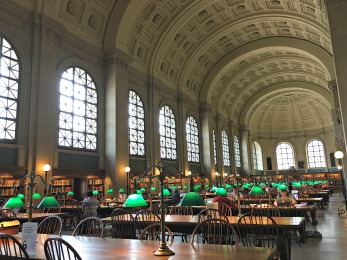
General information about Bates Hall
The reference reading room is named after Joshua Bates, who gave $50,000 so that a large reading room at the Boston Public Library could be built. The goal was to provide that "the building shall be such as to be an ornament to the City, that there shall be a room for one hundred to one hundred and fifty persons to sit at reading tables, and that it be perfectly free to all."
The reading room was created by Charles Follen McKim.
On the National Register of Historic Places, the library opened in 1852 as the first free, publicly supported municipal library in America. The library didn't open to the public until 1895.
In 2014, The Kirstein Business Library and Innovation Center took up temporary residence in the Bates Hall. The business center has been relocated to the lower level of the Johnson Building. From 1930 to 2009 it was located at 20 City Hall Avenue, in 2009 it was moved to be part of the central library. It was moved to Bates Hall during the reconstruction of the Johnson building.
Bates Hall makes a great venue for company parties and wedding receptions. You can get more information at the Boston Public Library event page.
About Joshua Bates
Joshua Bates was born on October 10, 1788, in Weymouth, Massachusetts. He was an international financier. He acquired much of his wealth as a senior partner of Baring Brother & Company of London.
Hethe first major contributor to the country's first municipally supported library. He donation $50,000 in 1852 to help jump start the library. (That would be equivalent to $1,437,450.60 in 2015) He also gave 30,000 volumes to the library.
Joshua died on September 24, 1864, and is buried at the Kensal Green Cemetery in Kensal Green, Greater London, England.
List of Busts that are in Bates Hall
| Joshua Bates | International Financier | October 10, 1788 - September 24, 1864 |
| Wendell Phillips | American abolitionist, advocate for Native Americans, orator and lawyer | November 29, 1811 - February 2, 1884 |
| Thomas Gold Appleton | American writer, an artist, and a patron of the fine arts. | March 31, 1812 - April 17, 1884 |
| Sir Walter Scott | Scottish Historical Novelist, Playwright and Poet | August 15, 1771 - September 21, 1832 |
| Benjamin Franklin | Founding Fathers of the United States | 1706-1790 |
| George Ticknor | American Academician and Hispanist | August 1, 1791 - January 26, 1871 |
| Henry Wadsworth Longfellow | Author and Personality | February 27, 1807 - March 24, 1882 |
| William Whitwell Greenough | Boston Merchant and Politician | 1818 - 1899 |
| James Fenimore Cooper | Popular Writer of the early 19th century | September 15, 1789 - September 14, 1851 |
| Edward Everett | Massachusetts Politician | April 11, 1794 - January 15, 1865 |
| John Joseph Williams | American bishop of the Roman Catholic Church | April 27, 1822 - August 30, 1907 |
| Hugh O'Brien | 31st Mayor of Boston | July 13, 1827 - August 1, 1895 |
| Oliver Wendell Holmes | Associate Justice of the Supreme Court of the United States | March 8, 1841 - March 6, 1935 |
Miscellaneous Trivia
- Bates Hall is 218 feet long, 42.5 feet wide, and 50 feet high
- There are 16 floor lights in the room
- There are 28 tables and 8 chairs to a table, total room capacity is 224
- Each table has two green lamps
- At the base of each green lamp are seat numbers that are used by the librarian runners
- There is a clock on both sides of the hall
- There are two reference rooms, on both sides of the Hall. You can ask for help with a reserved book from these location.
- Congressional Record books are on the South side of the hall near the Kristen Science Center side
- Seat #1 is near the Kristen Business Branch side
- Oliver Wendell Holmes is the only person to have a bust in the Bates Hall who was born after the library was opened to the public.
- Helen Keller visited Bates Hall on April 26, 1892
Some Interesting Books/Collections around Bates Hall
- All the books that align the shelves in Bates Hall are Social Science Reference Books
- You can find reference books in just about every city and town in Massachusetts. Find out which city/town started out as Danforth Farms.
- The Boylston Room, next to Bates Hall, has Documentary History books of all the Presidents.
- Along one of the walls in Bates Hall is a set of bright red books that contain Catalog abstracts of all the Declassified Government Documents.
- You can find the latest law books in Bates Hall.
Some people think that Bates Hall is "internationally recognized as perhaps the single most beautiful room in America." On your next trip to Boston, stop at the Boston Public Library and check out Bates Hall.
PermalinkMary Dyer
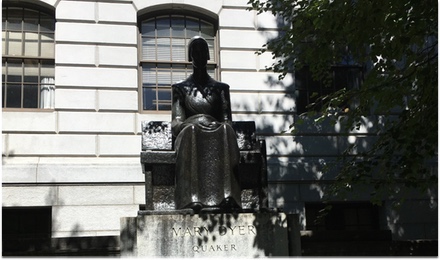
In front of the Massachusetts State House are two women statues, the first two women statues in the Commonwealth of Massachusetts: Anne Hutchinson (April 14, 1922) and Mary Dyer (July 9, 1959).
Anne Hutchinson statue is by the West Wing and Mary Dyer is on the East Wing.
Who was Mary Dyer?
Mary Dyer was a Quaker who kept visiting Boston to meet up with her friends in jail. Local officials had requested her not to come to Boston. But she defied the order and paid the ultimate price.Here's a brief version of what happened to Mary Dyer:
In Colonial Massachusetts Puritans didn't have a favorable view of Quakers. Quakers would constantly interrupt Puritan's sermons with their own views.
In 1657 the General Court of Massachusetts who rules, "anybody who should lodge a Quaker should be fined for such offence at the rate of 40 shillings for every hour of such concealment...that every Quaker man after being once punished and banished should presume to return should have one of his ears cut off for the first offence, and for a second offence his other ear, and for a third offence should have his tongue bored through with a hot iron."
One night Mary Dyer, who became a Quaker while visiting England, was passing through Boston to her home in Rhode Island. She was arrested and imprisoned. She was released by the request of her husband.
A couple of years later, she returned to Boston to visit friends that were imprisoned. She was brought before the court, with her friends, and was told to get out of Massachusetts within the next 48 hours. If they were sill in the commonwealth after that time, they would be put to death.
Mary Dyer left Massachusetts to Rhode Island but returned to Boston 30 days later to visit other Quaker friends that were imprisoned. She was arrested and on October 27, 1659, was to be hanged.
Her son pleaded to the court for her release The court agreed and allowed her to return to Rhode Island.
In May 21, 1660, she returned to Boston. She was arrested and given the death penalty. The court wasn't going to accept any reprieve.
She was told by Governor John Endecott, the first Massachusetts Governor, "You will own yourself a Quaker, will you not? The sentence was passed upon you at the last General Court... now it is to be executed. Therefore prepare yourself tomorrow at 9 o'clock."
On May 22, 1660, at 9am she was taken from the Boston Gaol to the Great Elm of the Boston commons, a noose was placed around her neck, she was then asked if she would "go home and stay there."
She responded with "Nay. In obedience to the will have the Lord God I came, and in His will, I will abide faithful unto death."
Mary Dyer died minutes later. Her body was returned to her family in Rhode Island.
Why was the Statue Created?
Zeno Ellis, a banker from Vermont, put the following in her will
"I give and bequeath to the State of Massachusetts the sum of $12,000 for the construction and permanent erection on the grounds of the Capitol or State House in the City of Boston in said the State of Massachusetts as appropriate statue of my ancestor Mary Dyer who died in the year 1660."
Statue Information
The figure on the Statue is looking towards the Boston Commons where Mary Dyer was hanged. Her back is to the legislature as if to make a statement about her death. She is wearing typical Quaker clothes.
The sculpture was created by Sylvia Shaw Judson. She is perhaps best known for the 'Bird Girl' sculpture which was used on the cover of "Midnight in the Garden of Good and Evil"
PermalinkWilliam Billings
Next to the entrance gate of the Central Burying Ground in the Boston Commons is a marker for William Billings:
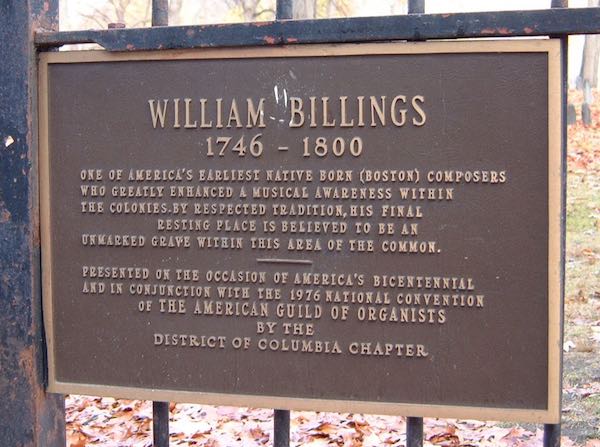
About William Billings
William Billings was one of the first American-born composers. He was singing master who tutored music to many wealthy families in Colonial Massachusetts.
He created songs that help inspired those that were fighting in the American Revolution.
Unfortunately he couldn't capitalize on his work because the newly formed country didn't have a well-established copyright system in place. He spent his final days as a poor sick man.
When he died his family couldn't afford a grave marker. He is buried in an unmarked grave someplace in the Central Burying Ground.
Central Burying Grounds
The Central Burying Grounds did encounter an incident in 1895. A few graves accidentally unearthed during the initial construction of the MBTA Subway system.
The unearth bodies were moved to a single gravesite. This is likely where William Billings final resting place is.
There is a marker to indicate where the bodies were relocated:
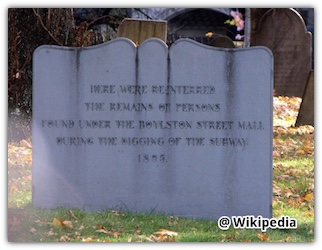
"Here were interred the remains of persons found under the Boylston Street Mall during the digging of the subway, 1895"
Misc Trivia about William Billings
- Born October 7, 1746 and died September 28, 1800
- William was blind in one eye, had a short leg and had Poland Syndrome. He enjoyed inhaling powdered tobacco.
- Married Lucy Swan on July 26, 1774. Lucy died in Boston in 1795. (I Wasn't able to find her burial site)
- They had nine children: Rachel, Abigail Adams, Elizabeth Adams, William, Lucy, Sarah, William, Peggy Dawes, Lucy
- He was a music educator that full filled the need for to improve congregational singing in the Churches in the mid-1700s.
- He was the best known and probably the most prolific composer in 18th century America.
- Billings has been called "the first important American composer"
- His friends included Samuel Adams and Paul Revere.
- Due to non-existent Copyright laws at the time, Mr. Billings didn't get a lot of credit for his music.
- William last job was a street sweeper in Boston.
- If there was an American Top 40s music list during the post revolution era, the song 'Chester' would have been in the top 10.
- Chester was sung in many churches during the American Revolution
You can find William Billings: Wake Evr'y Breath album on iTunes. His music is usually played around American Independent Day.
Listen to "Chester" on YouTube with Lyrics:
William Billing Most Well Known Songs
- Chester
- I am the Rose of Sharon
- Africa
- Creation
- Wake Ev'ry Breath
- Mourn, Mourn
- Chesterfield
When visiting Boston
If you plan on visiting Granary Burying Ground or King's Chapel Burying Ground, you may want to include the Central Burying Grounds as part of your tour.
October 7th, 2016 marks his 270th birthday.
PermalinkAbout
There are many interesting things and places around Boston, MA that you should know about. Here are a few that caught my attention. From historical sites such as the USS Constitution Museum, the Freedom Trail, and the iconic Fenway Park, to modern attractions like the New England Aquarium, the Boston Public Market, and the Isabella Stewart Gardner Museum, there is something for everyone. Whether you are looking for a fun family trip or a romantic getaway, Boston has it all.
Check out all the blog posts.
Blog Schedule
| Sunday 13 | Misc |
| Monday 14 | Media |
| Tuesday 15 | QA |
| Wednesday 16 | Pytest |
| Thursday 17 | PlayWright |
| Friday 18 | Macintosh |
| Saturday 19 | Internet Tools |
Other Posts
- 200 Clarendon Artwork
- Happy Place
- Henry Bradford Endicott tablet
- Coconut Grove Night Club Fire
- Fake Monks
- Eugène Létang Bronze Tablet
- Louisburg Square
- Nathaniel Lewis Gravestone
- Joseph A. Langone Jr. Memorial
- Thomas Seward Gravestone
- Boston Sign
- Love Locks on Massachusetts Ave
- Early Signs of Spring
- Boston Spring 2018
- Map of Back Bay at the Back Bay MBTA Station